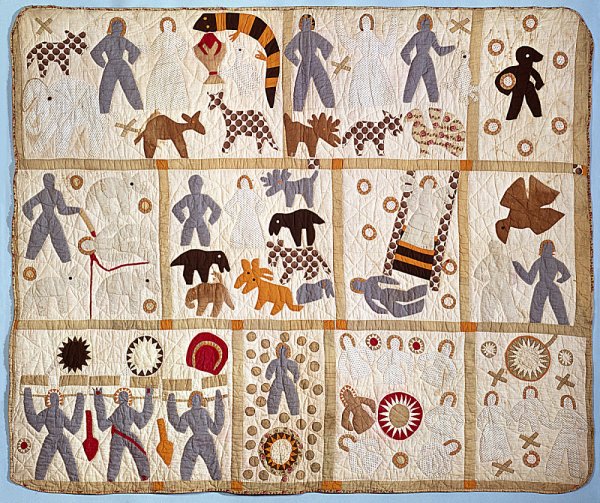Harriet Powers was born a slave near Athens, Georgia, on October 29, 1837. At a young age, she married Armstead Powers and they had at least nine children. Sometime after the Civil War they became landowners. Eventually, circumstances forced them to sell off part of the land but not their home. The date of Harriet's death, Jan. 1, 1910, was recently discovered on her gravestone in Athens Gospel Pilgrim. She made this quilt in about 1886. She exhibited it at the Athens Cotton Fair of 1886 where it captured the imagination of Jennie Smith, a young internationally trained local artist. Of her discovery, Jennie later wrote: "I have spent my whole life in the South, and am perfectly familiar with thirty patterns of quilts, but I had never seen an original design, and never a living creature portrayed in patchwork until the year 1886, when there was held in Athens, Georgia, a 'Cotton-Fair,' which was on a much larger scale than an ordinary county fair … In one corner there hung a quilt which 'captured my eye' and after much difficulty I found the owner, a negro woman, who lives in the country on a little farm whereon she and husband make a respectable living.... The scenes on the quilt were biblical and I was fascinated. I offered to buy it, but it was not for sale at any price.” Later Jennie sent word that she would buy the quilt if Harriet still wanted to dispose of it. Harriet offered it for ten dollars, but Jennie only had five to give. Harriet went out to consult her husband and reported that he said she had better take the five dollars. Mrs. Powers regretfully turned over her precious creation, but only after explaining each of the eleven panels of the design, which Jennie Smith recorded. Briefly, the subjects are Adam and Eve in the Garden of Eden, a continuance of Paradise with Eve and a son, Satan amidst the seven stars, Cain killing his brother Abel, Cain goes into the land of Nod to get a wife, Jacob's dream, the baptism of Christ, the crucifixion, Judas Iscariot and the thirty pieces of silver, the Last Supper, and the Holy Family. In her narrative about the quilt, artist Jennie revealed why she was so taken with it: "Her style is bold and rather on the impressionists order while there is a naivete of expression that is delicious." In recent times historians have compared Harriet's work to textiles of Dahomey, West Africa. (https://americanhistory.si.edu/collections/search/object/nmah_556462)
%20(1).png)
%20(1).png)






